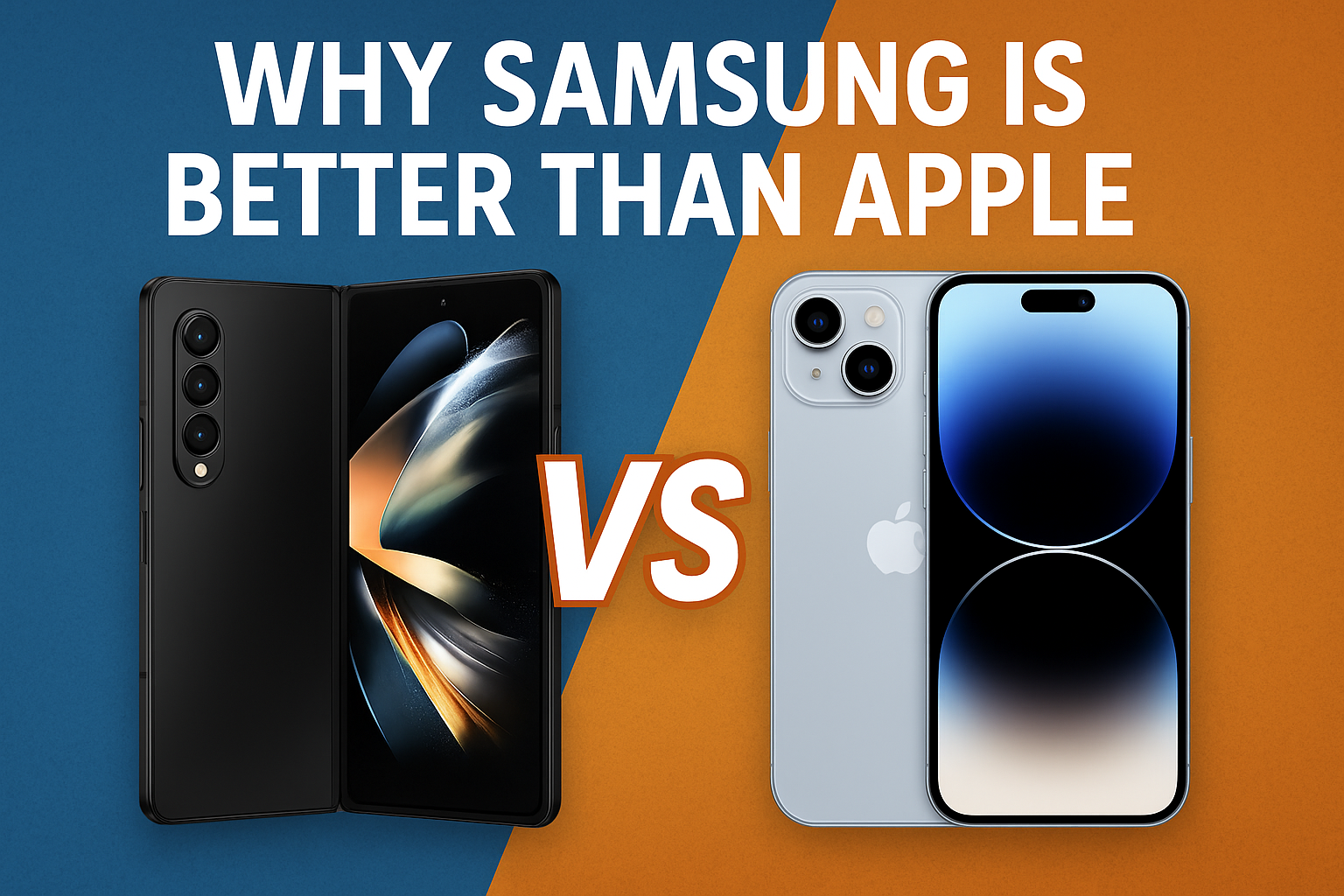Introduction
In the tech world, the debate between Samsung vs Apple continues to divide fans. Both brands dominate the premium smartphone market with massive global followings. But as we move through 2025, one brand is emerging as the clear leader in innovation, versatility, and value: Samsung. From foldable devices and high-resolution cameras to cutting-edge AI features and broader customization options, Samsung is redefining what a smartphone can be. In this post, we’ll explore the top reasons why Samsung outshines Apple this year.
1. Hardware Innovation and Variety
Samsung has established itself as the undisputed leader in smartphone innovation, especially with its Galaxy Z Fold and Galaxy Z Flip series. These foldable smartphones offer a glimpse into the future of mobile devices—offering compact portability with tablet-like functionality. Apple, on the other hand, has yet to release a foldable phone or anything comparable.
Furthermore, Samsung caters to a wider range of users. Whether you’re seeking a budget-friendly phone (like the Galaxy A14) or a top-tier flagship (like the Galaxy S24 Ultra), there’s something for everyone. Apple’s iPhone lineup remains limited in variety, typically focused on premium devices.
2. Camera Superiority
Samsung consistently pushes the boundaries of smartphone photography. The Galaxy S24 Ultra, for instance, is equipped with an astonishing 200MP main camera sensor, capable of capturing stunning detail even in low-light conditions.
Another standout feature is 100x Space Zoom, allowing users to photograph distant objects with incredible clarity. Apple’s iPhone 15 Pro Max, while impressive, is limited to 5x optical zoom, offering less flexibility for creative and long-distance photography.
Samsung also includes Pro camera modes, AI-enhanced features, and better manual controls—making it a favorite among photography enthusiasts.
3. Display Quality
When it comes to displays, Samsung is the industry gold standard. Their Super AMOLED panels offer superior contrast, deeper blacks, and more vibrant colors compared to Apple’s OLED screens.
Samsung’s flagship models boast a 120Hz refresh rate, ensuring smoother animations and touch responsiveness—ideal for gaming and media consumption. Plus, Always-On Display technology allows users to view time, notifications, and battery status at a glance, a feature that’s still limited in Apple’s ecosystem.
Samsung manufactures its own display technology and supplies panels to other brands, including Apple—giving it a competitive edge in quality and performance.
4. Faster Charging and Battery Features
Samsung’s phones support super-fast wired charging up to 45W, enabling users to fully charge their devices in under an hour. In addition, features like reverse wireless charging allow you to power up other gadgets (like earbuds or a friend’s phone) using your Samsung device.
In contrast, Apple’s iPhones support a maximum of 27W wired charging, which is significantly slower. Apple only recently switched to USB-C in the iPhone 15 series, whereas Samsung has been using this universal standard for years—making it more convenient and future-proof.
5. Customization Options
One of Android’s biggest advantages—especially with Samsung—is deep customization. Users can personalize almost every aspect of their device, including:
- Home screens with custom widgets and icon packs
- Dynamic wallpapers
- Third-party launchers and themes
- Lock screen styles and fonts
Apple’s iOS, while cleaner and more uniform, offers very limited customization. If personalization and control matter to you, Samsung easily takes the lead.
6. Ecosystem Flexibility
While Apple’s ecosystem is tightly integrated, it can feel restrictive. You need to stay within the Apple universe to get the full experience—MacBook, iPad, AirPods, etc.
Samsung, however, provides ecosystem flexibility without locking you in. You can seamlessly pair your Galaxy phone with:
- Windows laptops (via Samsung Flow or Phone Link)
- Android tablets
- Smart TVs
- Galaxy Buds, smartwatches, and more
This openness allows for a more adaptable experience, especially if you use products from different brands.
7. Better Price Range
Samsung covers a wide spectrum of price points—from budget to ultra-premium. Their mid-range phones often include flagship-level features like AMOLED displays, 5G support, and powerful cameras.
On the other hand, Apple offers limited options below its premium line. Even the entry-level iPhone SE feels outdated in design and lacks many modern features.
Whether you’re on a tight budget or looking to splurge, Samsung delivers more value for your money.
8. Productivity & AI Features
Samsung’s devices are packed with tools for productivity and creativity. Notably:
- The S Pen on Galaxy Ultra and Fold models offers precision note-taking, drawing, and control options unmatched by Apple.
- Galaxy AI brings smart features like live call translation, real-time subtitle generation, AI-based photo editing, transcription, and summarization tools.
Apple has made some AI strides with iOS 18, but Samsung’s AI and stylus support are currently more advanced, especially for users who need productivity on the go.
Conclusion
In 2025, Samsung has clearly stepped ahead with devices that not only keep up with the future but help define it. Whether it’s through foldable innovation, pro-grade cameras, powerful AI tools, or an open ecosystem—Samsung gives users more power, choice, and flexibility.
If you’re considering your next smartphone and value freedom, functionality, and features, Samsung is the smarter pick.
Watch the Video
Prefer a quick video summary? Watch the visual comparison below 👇
If you wish to read in hindi – go to https://thewhyguru.com/samsung-apple-%e0%a4%ac%e0%a5%87%e0%a4%b9%e0%a4%a4%e0%a4%b0-%e0%a4%95%e0%a5%8d%e0%a4%af%e0%a5%8b%e0%a4%82/
